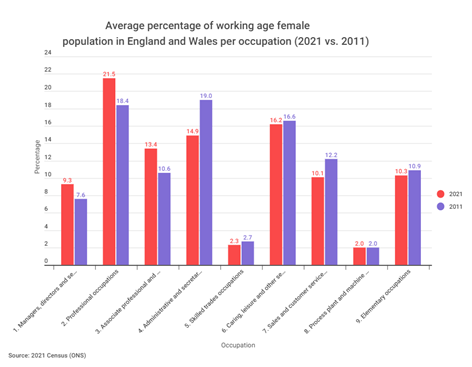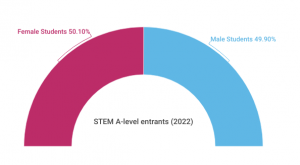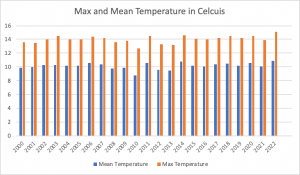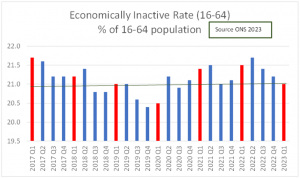Women on top: Census reveals surge of women in professional and managerial roles
New 2021 Census data shows that women in England and Wales are making a strong move towards professional, managerial, and directorial roles. The increase comes after decades of women accepting low-level jobs rather than aiming higher.
Affected by sexism, gender pay gaps and childcare restrictions, women fight for their pay and opportunities with ‘national screams’ and protests.
Women in the UK are paid on average nearly 15% less than men, according to the UK Parliament.
The number may be discouraging but is not stopping women from pursuing higher roles.
Data from the 2021 UK Census shows that an average of 21.5% of women in England and Wales are now in professional occupations, such as teachers, lawyers, and doctors. This is a 3.1% rise since the 2011 Census.
This professional area is now the largest for women and directly shows the shift of women aiming towards higher-paying jobs typically held by men.
Significantly, the presence of women in the ‘manager, director and senior official’ sector has increased by 1.7% between 2011 and 2021, equivalent to 280,000 individuals. This means an impressive number of women have moved into male-dominated areas, resulting in an average of 9.3% of women in these roles.

As expected, London and the South East have the highest percentage of women in managerial roles with 11.6% and 11.1% respectively, going down to 7.7% in the North East.
However, the census was completed during covid – a time of economic turbulence, so employment rates in some sectors may be inaccurate due to people on furlough.
The UK’s Financial Times Stock Exchange (FTSE) Women Leaders Review 2022 reported that 64 of the FTSE’s 100 largest market value companies have “at least one woman in one of the four key roles of Chair, SID, CEO or FD”, but only nine women hold the prized CEO position. Still, the FTSE has given its companies a 40% Women Executives target to help women fulfil their ambition.
Similar company targets across the UK should drive the number of women in the first occupational sector even higher by the next Census.
On the opposite side of the FTSE, female small business owners are struggling. Many women kick off their directorial career with a start-up company or even just a small stand at a market.
But the number of female entrepreneurs remains low. In 2021, only 19% of small and medium-sized enterprises were led by women, the government BEIS department reports.
Many women are also nervous about starting their own businesses due to problems that men don’t face.
Women are twice as likely as men to mention family responsibilities as a barrier to starting a business, reports the HM Treasury. The Chancellor has recently taken action to support women at work by announcing “a childcare revolution with 30 hours free childcare for children over the age of nine months.”
Only 1% of all venture funding goes to businesses founded by all-female teams, inhibiting scale-up, according to the UK VC & Female Founders 2019 report. For many, it is simply a lack of understanding of how business works.
But that doesn’t stop Leicester-based small business owner Grace Kensington from giving it a try. She makes frog, mushroom and worm prints and stickers, and tries her hand at “The Mice Girls” cards for all occasions.

After starting her Etsy and Redbubble shops in 2020, Grace has seen her sales fluctuate, leaving her unsure of her next move.
She said: “Sometimes a drop doesn’t do as well as I expected, and I don’t know what to do. Seasonal cards do well, and my funky stickers have spontaneous bursts in popularity, but it’s never stable.”
Grace packages her work sustainably, which is costing her even more. “I love nature and sustainability, and that is what my business is all about and is inspired by,” she said, “but sustainability is more expensive, and my dedication is certainly making it hard to break even.”
She would like to make her business her main source of income, but it doesn’t seem possible. Her current admin job is keeping her afloat, with the small business becoming more of a hobby.
“Of course, I enjoy art more than my main job. It’s a dream to keep going and growing. But there are so many shops like mine, that it is hard to stand out.”
Grace believes finding investors is hopeless: “I would love to be my own boss but taking it further, employing people, and mass-producing my designs and prints requires the money I don’t have and won’t be given.”
The number of women in admin and secretarial jobs like Grace’s has fallen by 4.1% from its top spot in 2011 down to 3rd. But Grace said that it is unlikely that she will ever reach the managerial sector, in her own business at least.
She said: “I’ve accepted that this is my side hustle and I’ll have to continue on and up, trying to find a well-paying art-related job, which is just as difficult.
“It’s awesome that women are aiming higher, and I’m rooting for us, it’s what we deserve.
“Women with degrees becoming professionals and becoming bosses. I see the number of women in managerial roles reaching 20% in the next Census, so we should aim higher than ever.”




